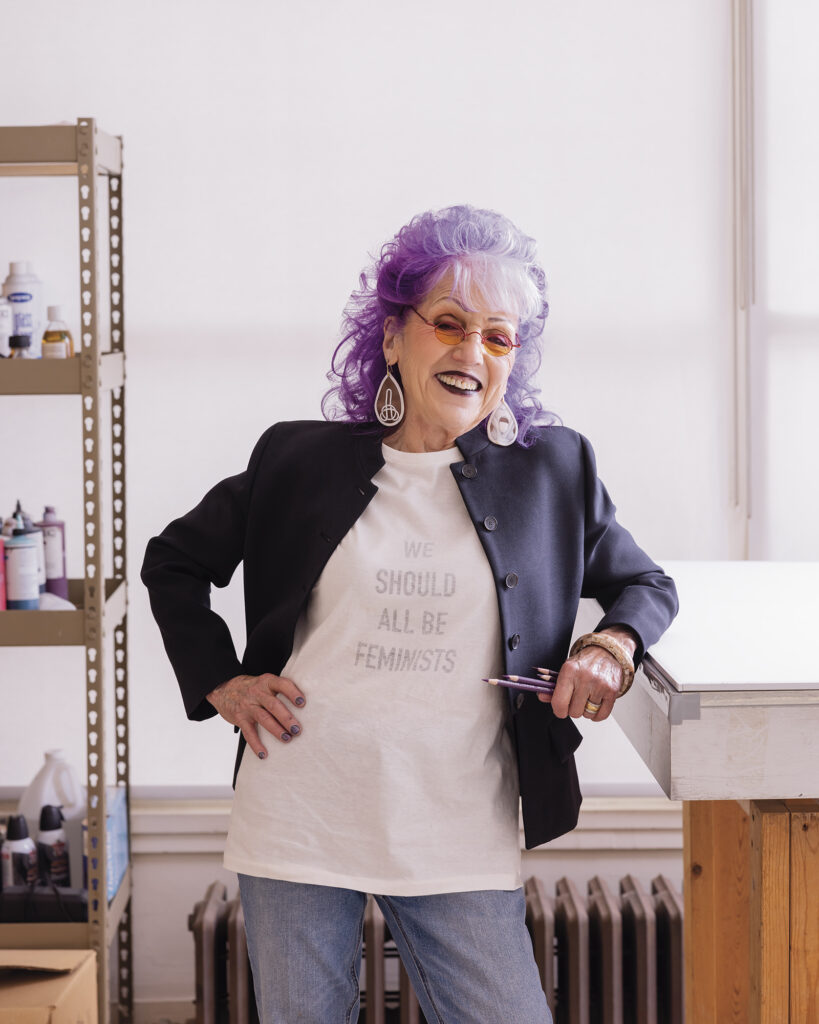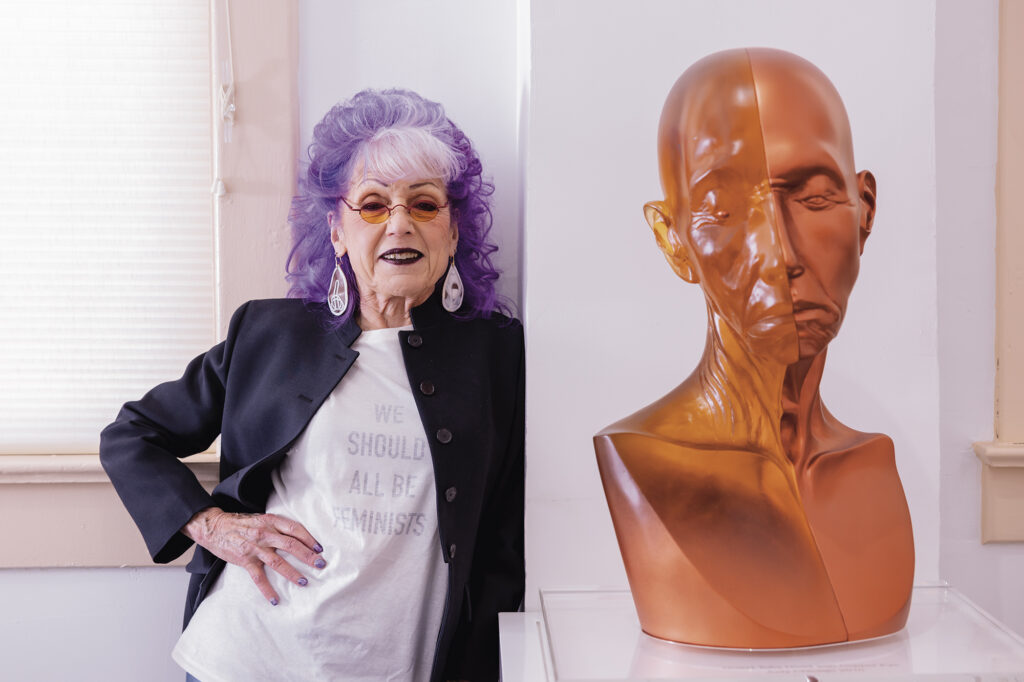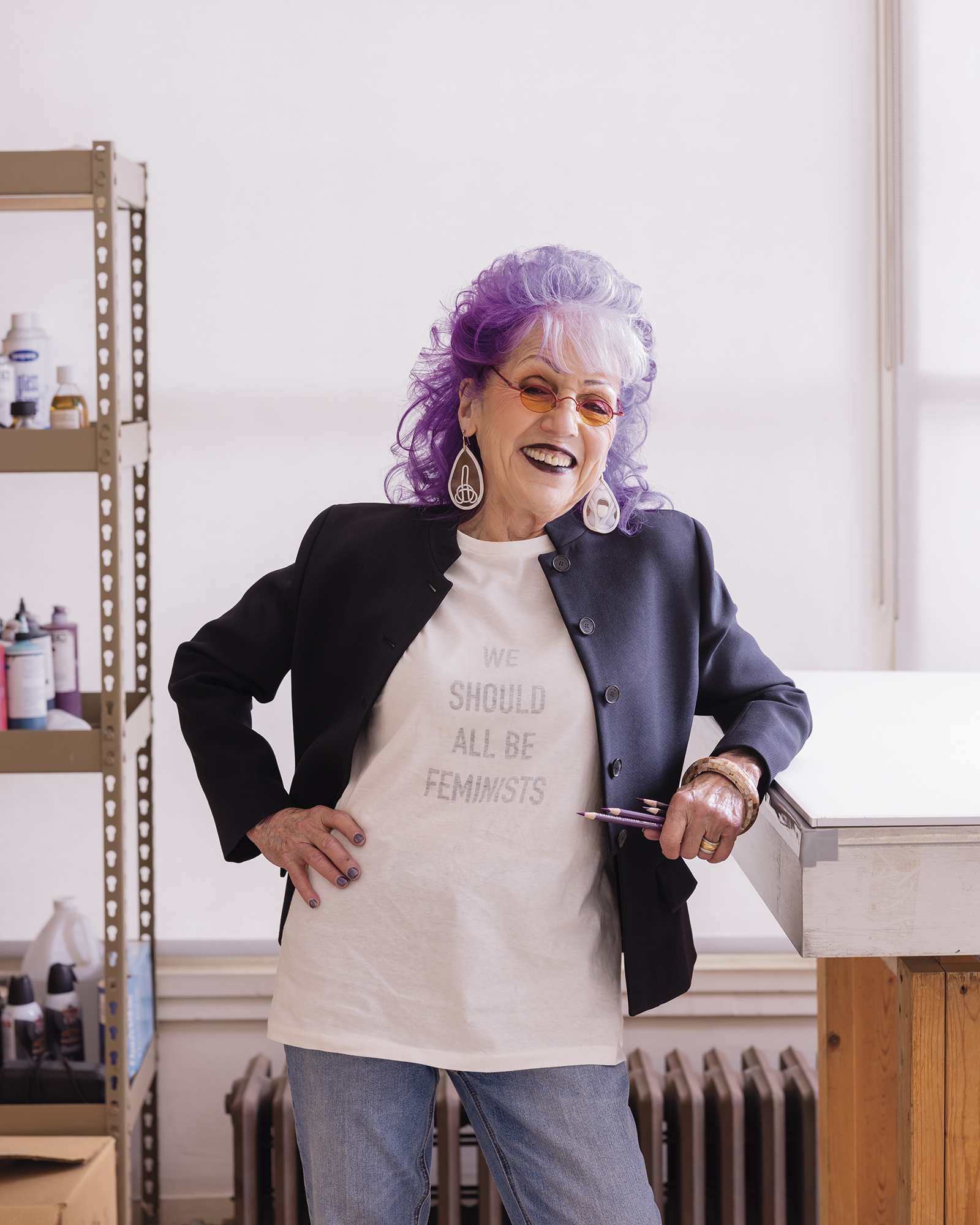At the entrance of Judy Chicago’s 1970 Cal State Fullerton exhibition hung a sign that read, “Judy Gerowitz hereby divests herself of all names imposed upon her through male social dominance and freely chooses her own name Judy Chicago.” That declaration, made almost 40 years ago, still sums up the artist’s work and mission today. Chicago and her practice have come to define contemporary art, a field that was denied to women for many centuries. Since then, she’s shown at the Brooklyn Museum, collaborated with renowned Dior Creative Director Maria Grazia Chiuri, and been named one of TIME 100’s Most Influential People. Now looking back at her over 50-year career, the artist is ready to tell her journey–on her own terms. And much like the artist herself, her autobiography doesn’t hold anything back.
Feminist art legend Judy Chicago retraces her early beginnings in the 1960s while speaking to her predictions for art in the digital age with close collaborator and friend, Nadya Tolokonnikova, of Pussy Riot.
NADYA TOLOKONNIKOVA: I have a lot of things that I want to ask you, but I guess I’ll start by asking a relatively simple question. What’s feminist art to you, Judy?
JUDY CHICAGO: It’s funny because I did a small image in the early ‘70s called, What is Feminist Art?, in which I tried to define it then. But now I have a different definition. Then, I saw everything through the lens of gender. I thought feminist art was primarily for women by women, but I don’t think that way anymore. Because to me, feminism is a philosophy. Now, I define feminist art as art that challenges that worldview.
NT: You also gave birth to the term “feminist art education” by establishing the very first feminist art education program. How did you come up with this truly revolutionary idea?
JC: Well, first of all, I didn’t realize how revolutionary it was. When I was in college at UCLA, my male painting professors made me feel like there was something wrong with my work. So I needed to go away [to a place] where I wasn’t feeling the pressure of the art scene, which wasn’t anywhere. I found a job in Fresno, which used to be called the “belly button” of California, and it was there where I gathered a group of young women who all said they wanted to be artists. We found a space where we could exist unapologetically, and I think that was really important.

I was just reading an essay for the catalog for my upcoming show at the New Museum next fall. The writer talks about my relationship to architectural space, and he cites the fact that I knew that my students had to be off-campus. They had to have a space of their own. They had to be away from the patriarchal paradigm and away from being seen the way they were seen within it. And so we found a space away, and I think that was really important. It was essential. What I had in my mind Nadya, you embody.
NT: Yeah, you made space for yourself by existing outside of the industry’s predefined lines.
JC: Exactly. And Nadya, I also want to ask you a question. From the beginning, my goal was a global feminist art movement. What gave you the courage, as a young artist, to take an openly feminist stance?
NT: It was anger. I’d seen injustice and inequality. From a very early age, I’ve seen that I live in a world made by men and made for men. We studied only male scientists, male artists, male kings, and male historians. And even when it was a female historian, they were still writing about male figures. I started to identify as a feminist, and then somebody asked me why there were no great women artists. I was just a kid in Siberia, but I started to do my research and I realized that feminism is much more than just a movement. To me, it’s something that helps me to stay sane because we, as an underrepresented group of people, are gaslit by the dominant ideology to think that there is something wrong specifically with us. I started to feel like I was losing my mind because I didn’t feel like I was heard. People were discouraging me from expressing my opinion, because not only was I young, but I was also a girl. Feminism became something that I started to cherish as one of my best friends, really. It became one of my best friends in this terrible sea of a male dominated world. Feminism is my comrade. I think the fact that I’m still sane is only because I discovered feminism.
JC: That’s really interesting because it was true for me too. Feminism and my discovery of the history of feminism and the fight for feminist values became my companion too. My father instilled a lot of confidence in me. When I was little, my father was a Marxist during The Red Scare–the anti-communist years–and he was targeted by [Joseph] McCarthy. At 13, I was confronted with these hideous popular magazines at school called The Weekly Reader that depicted my father as this horrible creature. I had to make a decision when I was young about whether to believe my own experiences or what the world told me. This stayed with me throughout my career and informed the way I navigate life and create art.
NT: I also wanted to ask you about painful moments in your career. You’ve been through many painful moments in your career, and when I read your book I cried because I felt so much empathy for you. I couldn’t believe all of the coincidences. For example, when museums were too scared to show your work, and they were hiding behind polite phrases like, “It’s too expensive, too big, doesn’t fit into our schedule.” And it’s especially hurtful because they don’t tell you that your work is too political, they just say it doesn’t fit into their schedule. How can you fight with that?
JC: Before I answer that question, let’s backtrack to how we connected. I had just read your book Read & Riot. As I told you when I met you, it was full of post-its because I had exactly the same reaction. I underlined things in your book that I could have said. It was quite overwhelming to understand that across the generations, across geography, across culture, that somehow we both had come to the same oppositional stance. Anyway, I’ve been asked that a lot, how I stood up to all the vitriol, and as everybody in the art world now, they have a term for it. “Judy’s been marginalized.’” Well, that’s a very polite way to say it.
NT: I mean they attempted to erase you. They didn’t succeed because you had strengths to fight for yourself. Where did you get that strength?
JC: I was actually just thinking about this because I’ve been writing my remarks for the gala at the New Museum. There are probably two parts to this answer. One is that I put my faith in art history. That’s the first thing I did: put my faith in art history. Secondly – I feel unbelievably fortunate that I’m seeing that faith justified, particularly in the catalog essays for the New Museum show. I can hardly believe the level of understanding of my work. I’ve never felt really understood before now. I had such a burning desire to make art through all those decades of “marginalization,” I made making art my reward. So as long as I could go into my studio and work, I was all right.
NT: Yeah, and my next question is about male allies. Judy, what makes a good male ally?
JC: Well, you and I both have male allies, right? I guess you can answer this question too. When I met my husband of 37 years, Donald Woodman, a photographer, I never in my wildest dreams thought I was going to get married again, because so many men were such jerks and they were so threatened by me. You know what I mean?
NT: Why are men intimidated by women like us? Because I’ve heard it so many times and I’m not exactly sure why.
JC: Let me see if I can answer that. I think it’s because we don’t fit into the expected construct of femininity. And the thing about Donald, when I met him, he was a truly radical man. He’d been in the anti-war movement. He was in Boston at the height of the anti-war movement, which actually happened to be a hotbed of feminism when he was there. Some years ago I was honored at the Brooklyn Museum along with these women who had written Our Bodies, Ourselves. We were all backstage and I said, “I have to thank you because my husband was in Boston when you were causing all that trouble and you turned him into a feminist.”

I’ll tell you something, he thought there was something wrong with him too, because he did not want to conform to the traditional male role. And in fact, rather than succumb, he lived in a tepee for seven years – totally self-sufficient, really independent, and didn’t give a – about all the things men are supposed to care about. And so it was like, “Oh my God, I can’t believe I met a man like this.” I hate to speak for Donald because he can speak for himself, but I think he found in feminism many explanations for why he had always felt like he didn’t fit in and like there was something wrong with him. And a man like that, needs women like us, so they don’t have to shrink themselves to fit into the construct of masculinity as too many women do. And we refuse to do.
As to why so many men are threatened, I mean, why were my male painting instructors threatened by my color and my female centered forms? Because that’s not what you’re supposed to paint. They’re enthralled by a set of values that I think a lot of men have never questioned and just being around us would force them to start to question the expectations. I cannot believe that men just willingly go to war to kill people. It’s like those poor Russian conscripts who are being sent out there in service to this patriarchal madman.
NT: I really loved your Instagram post you did for the eighth International Women’s Day, when the war with Ukraine just started. And you said that it was not the time to celebrate.
JC: Absolutely. No, it’s time to both mourn what the world has become and fight it.
NT: I really love this connection between war and the patriarchy that you’ve done your work and I feel it strongly as well.
JC: When we’re children, we’re told war is inevitable, right? It’s just part of the human condition. Well, why should that be? Why can’t we–especially the educated part of the world–why can’t we find other ways to resolve conflict than through the rule of force?
NT: You asked me about what makes a good male ally. I think first of all, I want them to think about human problems and human rights, not about male or female rights. When the Supreme Court of the United States made its terrible decision last year, I was talking to a lot of male friends of mine who supported my fight against Putin, but they didn’t feel want to support the movement for reproductive rights because they thought it was a women’s issue.
And it’s incredibly stupid to me. I think first of all, to be a good male ally, you need to understand that it’s a human issue. And especially when it comes to reproductive health and abortions. If we didn’t have men, we wouldn’t have to have abortion. There’s a penis involved, so by definition, it’s not just a women’s issue.
Since I was a teenage girl, I wanted to have an ally. It didn’t matter to me if it was male, female or non-binary. I wanted to find someone with whom I can be both romantically and artistically involved. And I dreamt of not confining myself to certain roles, but I was taught to be mostly heterosexual by growing up in a small provincial city in Russia. Seeking out a female lover was not an option for me. So I had to confine myself to traditional femininity to attract men. And it was ugly for me, I never actually loved it. I mean, I enjoyed them in terms of 1, 2, 3 nights, but it never could last. I always dreamt of a longer-term partnership on every single level. That’s what a dream was for me and I think I found it.
JC: I’m very happy for you because I totally understand that. Feminist issues are global issues – and feminist art has the capacity to challenge patriarchal values on a global level, but it requires women taking control of themselves, their lives, and standing up with male allies. We can’t do it by ourselves. We need male allies.
NT: I really loved your stance in our project, “What if Women Ruled the World?” We didn’t just ask women or women-identifying people, but we also asked men.
JC: Yes we did. In the same essay for the New Museum catalog, the writer talks about the Dior project and he talks about it in a way that is really, really interesting and highlights how that project extends my work of six of six decades into a global context. As I say, kind of repeatedly, the Dior project was the greatest creative opportunity I ever had. It was very interesting to me to read that not only is Maria Grazia Chiuri, the creative director of Dior, the first female creative director of Dior, but I read that Arnault, who owns Dior, pledged to make his staff 50/50. This means that there’s a global company who are actively trying to make a contribution to a world of justice and equality.
NT: That’s wonderful. And now, looking back, if you could give advice to your younger self, what would it be?
JC: My younger self? Well, actually, Nadya, I’m not sure I needed advice [laughs]. When I was 17 and ready to go to California, I said to my friends, “I have a destiny.” And they looked at me like I was crazy. But it was true. So I’d say the same thing to any young person, follow your own voice.
The Flowering: The Autobiography of Judy Chicago (Reedition) releases June 20th via Thames & Hudson.
This feature appears in the pages of V142: now available for purchase!
Photography Tira Howard
Fashion Emma Oleck
Makeup April Kateri Chavez
Hair Ronnie Torres
Discover More



